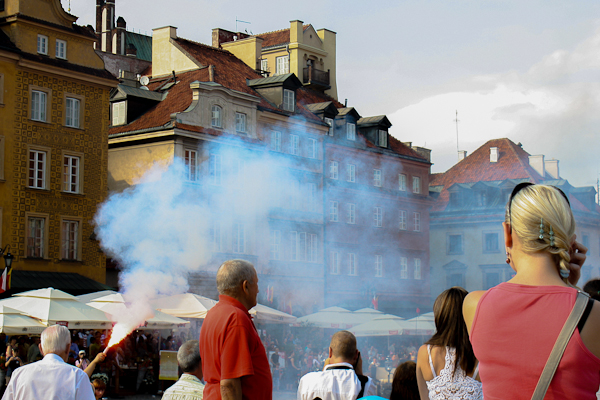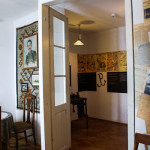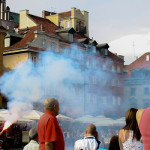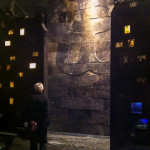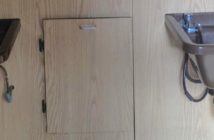Sitting on my desk is a small enamelware cup that I purchased in the gift shop at the new Schindler Factory branch of the Museum of the History of Krakow in Poland. The cup is blue, with a black rim and white interior. It is small, with a comically tiny handle, and as a functional object it’s not quite successful. On the front are printed the words:
Fabryka Emalia
Oskara Schindlera
Lipowa 4
(That is, the name of the Hollywood-famous factory-turned-museum, and the address, in Polish.) Purchasing this cup was the final participatory act of a museum visit that bordered on theater.
Comparing my museum experience to the theatrical is not an immediately negative critique. In Polish theatrical tradition the audience is paramount, and both audience members and performers are often pushed to the limits of their comfort zones. If you attend a theatrical performance (or spektakl), you might find you are held in the lobby until moments before the show begins, in order to build suspense and excitement for the impending performance. This practice stems from the work of Grotowski, one of the patron saints of Polish theatre, who utilized this practice as an aspect of his participation in paratheatre, a chapter of his career closely linked to Polish Happenings and performance art. With this in mind, audience engagement within Polish museums can be understood as drawing on, or contributing to, an existing tradition of engagement and diminishing the fourth wall.
Recently, there has been a rash of museum building in Poland, resulting in a number of highly modern history museums that provide a level of audience immersion just shy of time travel. The Warsaw Uprising Museum (opened in 2004) and the Schindler Factory Museum (opened in 2010) are already highly popular tourist attractions in their respective cities; new history museums are also in development, including the Museum of the History of Polish Jews and the Museum of Polish History in Warsaw, and the World War II Museum and European Solidarity Center in Gdansk. Their creation reflects both the impulse to preserve history at the places it occurred, as well as the organic creation of eager, rapt audiences as a result of foreign visitors’ participation in memory tourism.
| The best example of this might be the museum that now stands at the site of Schindler's factory. |
In the wake of the film Schindler’s List, visitors flocked to the city to retrace history—and shooting locations. A draw for visitors was, and still is, the traditionally Jewish district of Kazimierz, where today local hipsters cohabitate with Jewish memory. Here one can visit a Jewish cemetery, walk past pre-war synagogues, and eat at 'Jewish' (but not Kosher) restaurants. "Schindler’s List" tours, readily available to visitors in Krakow, take one to these places, as well as to the site of the former Jewish ghetto in Krakow and to the factory-turned-museum, pointing out shooting locations along the way.
Like many history museums, the permanent exhibition at Schindler’s Factory (titled Krakow Under Nazi Occupation, 1939-1945) is arranged chronologically, transporting the visitor to the beginning of World War II, then pushing them forward through time. As a branch of the Museum of the History of Krakow, the exhibition is a modern complement to the more traditional artifacts-in-vitrines museum space located on Krakow's rynek (main square). Here, the city of Krakow is recreated in miniature. Details of the exhibition design create the impression of traveling through urban space while differentiating one gallery from the next. At various times, one walks upon cobblestones, indoor tile, wood flooring, and loose gravel. Simultaneously, each section of the museum addresses a different moment or event within Krakow’s World War II history: the beginnings of Nazi occupation; the elimination of Jews; Polish resistance efforts; the creation of the ghetto and Plaszow labor camp. Historical moments become ‘checkpoints’ within the museum exhibition. At these places, visitors are invited to take a card printed in both English and Polish with the date and event, and stamp it with a seal that changes depending on the ruling authority of the moment.
Schindler himself retains the room that was once his office, which is still furnished with his desk and a German-language map of Europe. These artifacts are accompanied by a memorial in the form of a glass case filled with enamelware made in the factory. Accompanying wall text and printed materials make it clear that the objects in this room are authentic artifacts, but within other parts of the museum the line between artifact and artifice disappears. At one point, a reconstructed wartime apartment is decorated with objects that seem authentic to the time period along with others that are hard to date or seem likely to be contemporary. As far as its immersive power, this display is an accomplished portion of the exhibit, in the context of a museum’s function as a collecting institution, it sends mixed messages. Is preservation no longer paramount? Or are these contemporary objects also worthy of preservation?
One corridor of the museum recreates a street in Krakow under occupation, lined with Nazi flags. The flags are hung directly from the ceiling and brush against the shoulders of visitors as they walk past. Although I could find no label explaining these objects further, I can only assume they are reproductions. If so, will they be replaced once they became worn from the passing by of many visitors? Will they be discarded in a way that will ensure they are not resold as authentic, as unfortunately happens with many replicas of Nazi paraphernalia? As I walked through the corridor, I watched other visitors flinch with discomfort at the flags. Were they also wondering about the flags’ authenticity, or did it not matter to them?
At the Warsaw Uprising Museum, the visitor similarly enters a city-within-a-city. Although this is a museum that concerns a single event, and not the history of the city as a whole, the modern city of Warsaw is strongly defined by the events and aftermath of the Warsaw Uprising, which left the city in ruins. Today, small memorials and plaques honoring those who fought and died during the Warsaw Uprising are a ubiquitous feature on the city’s landscape. The kotwica (anchor) symbol of the Home Army, which led the Warsaw Uprising, can be seen everywhere, not only as part of these small memorials but also haphazardly scrawled in patriotic graffiti—and in the Warsaw Uprising Museum’s logo. Every year on August 1st at 5pm, the time and date at which the Uprising began, a siren sounds in cities throughout Poland and people pause to remember.
Given this relationship between event and landscape, it makes sense that the landscape, in turn, defines the museum. Within the museum, a cobblestone floor, brick walls, and ‘building’ facades labeled with signs and street numbers characteristic of those seen throughout Warsaw bring the exterior to the interior. (Similar details exist within the Schindler Factory Museum, as well, but here they are more definitive of the exhibition design.) Photographs are reproduced on a large scale, and artifacts are hung in arrangements that occupy full walls, creating tableaux reminiscent of a theatrical set. In this museum, as well, the visitor moves through time sequentially, and the passage of time is made tangible by calendar pages that one can take and collect throughout the permanent exhibition. Maps of the city of Warsaw also appear throughout the exhibit, a reminder to the visitor that they move through space as well as time. These maps illustrate the sections of the city under the control of the Home Army at various points during the uprising.
Even the museum café recreates an element of the city, allowing the visitor to step into an intimate prewar Varsovian café, in a way that is closely parallel to reconstructed spaces at the Schindler Factory Museum. (That café, it might be noted, is Hollywood-themed, kitschier even than most of the places that have cashed in on tourism surrounding Schindler’s List for decades.) Ordering a coffee at the Warsaw Uprising Museum’s café feels like an act of memory, a tribute to a vanished intelligentsia. Here, hung on the walls salon-style, are photographic portraits of individuals significant to the Uprising. Whereas the rest of the museum can overwhelm with information and interactive features, the café is a much calmer space, in which I always pause and intently look at their faces on the wall.
In Gdansk, the Roads to Freedom exhibition, dedicated to the Polish Solidarity movement, is a similarly immersive museum space. This exhibit is not a full museum, and will soon be replaced by a permanent exhibition within the European Solidarity Center, currently in development. The present exhibit is underground, in a bunker-like space. The exhibition here, too, is comprised of rooms that present facets of history in chronological order. And here one finds replicas of artifacts, beginning with the ticket to the exhibition, which mimics a coupon for rationed goods.
A visit to the exhibition begins and ends in a lobby-like space, which also includes the first section of the exhibit, a reconstructed grocery store harkening to 1970’s Poland. The shelves in the shop are nearly empty, impressing on the visitor the scarcity that existed during the time period. Standing outside the constructed shop is the mannequin of a haggard-looking woman carrying toilet paper. This constructed shop stands directly opposite the ticket counter, which also serves as a gift shop, where visitors can buy their tickets as they arrive and souvenirs as they leave. As I purchased some postcards at the end of my visit, I was suddenly hyper-aware of my engagement with capitalism, and once again even the gift shop became a participatory act.
In several sections of the museum, photographs are enlarged to cover the wall, creating a theatrical backdrop that recreates specific moments more than the city of Gdansk itself. In a corridor illustrating the imposition of martial law in Poland, photographs of riot police and terrorized citizens are reproduced large enough to cover the walls. Mannequins stand in front of this backdrop, occupying space that visitors might otherwise walk through. For a moment, the visitor is also an individual facing the riot police, although the grainy quality of the photographs and the low level of realism of the mannequins make the illusion flimsy.
In museum spaces such as these, visiting the museum becomes a performative act. Although these museums are highly successful at achieving in-depth visitor interaction—at the present moment, a holy grail of museological standards— what is routinely sacrificed is a focus on the object and the artifact. But it must be acknowledged that, at least within these exhibitions, education and engagement occur even where objects and spaces are fabricated reconstructions. Perhaps one could argue that the purpose of a history museum is preservation of the past, with the preservation of artifacts as only one aspect of the overall project of salvaging history. I am hesitant to suggest that the function of the museum has changed, and that the concept of the artifact itself is a relic of the past. But what is clear is that the term ‘museum’ embodies a wide variety of institutions and spaces that combine and adapt methods in pursuit of similar ends. Even in exhibitions such as these, where the visitor steps into a theatrical ream, they interact with the space with an understanding of it as a museum. And as museums continue to evolve, visitors’ conceptualization of a space might be the one defining element that denotes a museum from all other kinds of places.

